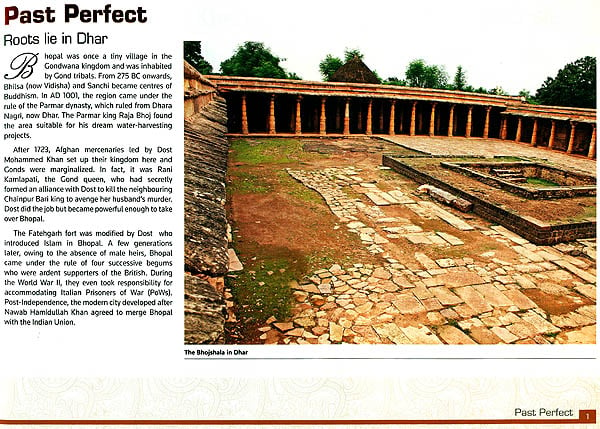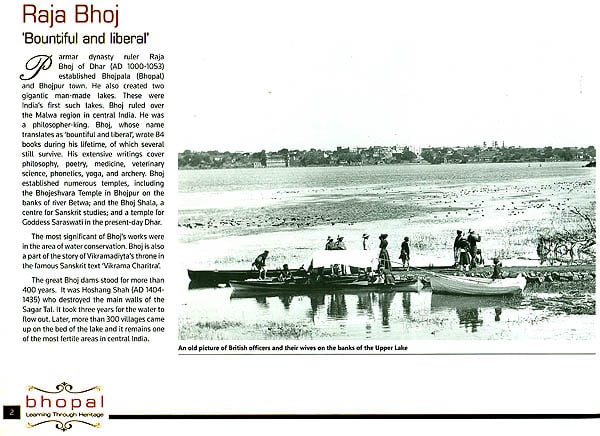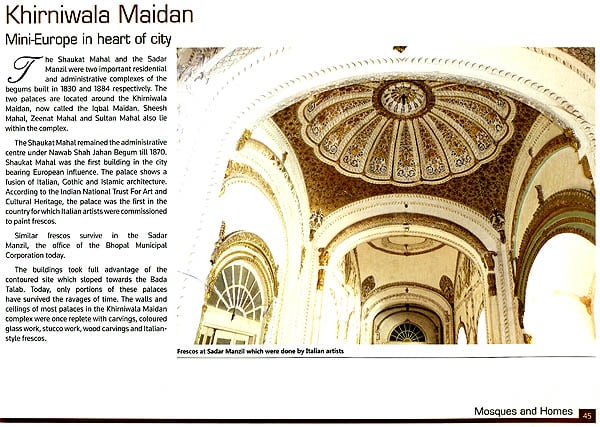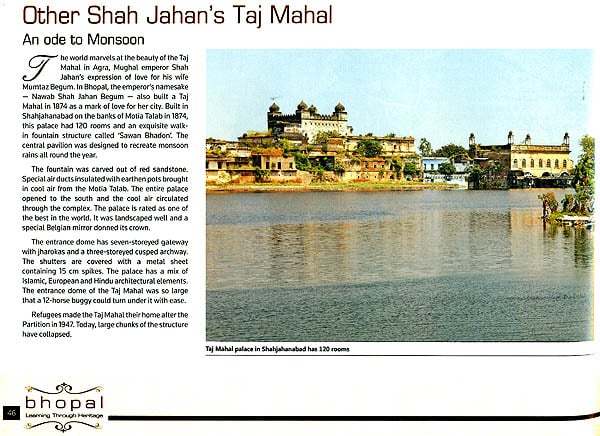
Bhopal (Learning Through Heritage)
Book Specification
| Item Code: | NAF387 |
| Publisher: | Bennett, Coleman and Co. Ltd. |
| Language: | English |
| Edition: | 2011 |
| ISBN: | 9789380942759 |
| Pages: | 82 (Throughout Color and B/W Illustrations) |
| Cover: | Paperback |
| Other Details | 8.0 Inch x 11.0 Inch |
| Weight | 410 gm |
Book Description
It has been 100,000 years since the early cavemen settled in the Bhimbetka caves Bhopal and about 2,250 years since Emperor Ashoka made Sanchi the hub of Buddhist learning. Raja Bhol ruled over the large Gond kingdom from Dhar which extended to Bhopal and beyond about 1,000 years ago. Dost Mohammed Khan arrived on the scene some 300 Years ago and thus began Bhopal Bhopal’s journey as a city that socially and culturally evolved into a unique human settlement with an endearing character marked by tolerance and pluralism.
Coming shortly after the launch of the Bhopal edition of The Times of India, this coffee table book aims to capture the essence of Bhopal’s past which many of our readers, who are new settlers in this boom town, may not be familiar with. The book is an attempt to sensitize even old times who may have become immune to Bhopal’s charms to the richness of the heritage and the need to preserve it.
Few would know that is was pt Jawaharlal Nehru who saved the Fatehgarh fort, the city’s bastion for many centuries, from complete destruction. The fort now falls within the Gandhi Medical College premises. During the construction of the college, which took even years, the Fatehgarh fort was under attack not by enemies trying to invade the city but by planners who did not deem it necessary to preserve this historic monument. When the new building of the college was being inaugurated on March 13,1963, Nehru noticed a huge wall being hammered down. He directed that further demolition of Bhopal’s citadel be stopped. The shadowy remains of the fort still thank to his intervention.
But heritage is not just about built structures. It is about people their culture and way of life. The walled city, which is the soul of Bhopal is a living museum of human habitation. It is here that we find communities co-existing in complete harmony and mutual dependence, keeping traditions arts and crafts alive. It is here that quaint shrines are thronged by followers of all faiths and differences are drowned in the numerous lakes that are strewn around this beautiful city.
At the root of this liberalism was the reign, spanning more than a century, of begums who not only believed in gender equality but also respected the sentiments of the majority Hindu Community. Often, their prime ministers were Hindus. Though Bhopal was an Islamic state, the begums allowed the St Francis church to come up in the 19th century in Jehangirabad. Sir Ross Masood, an education minister of pre-Independence Bhopal, became involved with the restoration of the world’s largest 9th century Shivling in Bhojpur when he invited conservation architects from Chennai to the Job.
The task of conserving and preserving heritage is a delicate one. All the stakeholders should be convinced that this is for their own good and for the improvement of quality of life in Bhopal. It is said that heritage is an essential part of the present we live in and of the future we well build. Any society that tends to forget its roots is headed for ruin. Only reverence for our past will bring a vision for the future. By delving into the city’s glorious past, this book express the times of India’s commitment to partner with Bhopal and build a bright future for the city and its people.
It has been 100,000 years since the early cavemen settled in the Bhimbetka caves near Bhopal and about 2,250 years since Emperor Ashoka made Sanchi the hub of Buddhist learning. Raja Bhoj ruled over the large Gond kingdom from Dhar - which extended to Bhopal and beyond - about 1,000 years ago. Dost Mohammed Khan arrived on the scene some 300 years ago and thus began Bhopal's journey as a city that socially and culturally evolved into a unique human settlement with an endearing character marked by tolerance and pluralism.
Coming shortly after the launch of the Bhopal edition of The Times of India, this coffee-table book aims to capture the essence of Bhopal's past which many of our readers, who are new settlers in this boom town, may not be familiar with. The book is an attempt to sensitize even old-timers - who may have become immune to Bhopal's charms - to the richness of the city's heritage and the need to preserve it.
Few would know that it was Pt Jawaharlal Nehru who saved the Fatehgarh fort, the city's bastion for many centuries, from complete destruction. The fort now falls within the Gandhi Medical College premises. During the construction of the college, which took seven years, the Fatehgarh fort was under attack - not by enemies trying to invade the city but by planners who did not deem it necessary to preserve this historic monument. When the new building of the college was being inaugurated on March 13,1963, Nehru noticed a huge wall being hammered down. He directed that further demolition of Bhopal's citadel be stopped. The shadowy remains of the fort still stand, thanks to his intervention.
But heritage is not just about built structures. It is about people, their culture and way of life. The walled city, which is the soul of Bhopal, is a living museum of human habitation. It is here that we find communities co-existing in complete harmony and mutual dependence, keeping traditions, arts and crafts alive. It is here that quaint shrines are thronged by followers of all faiths and differences are drowned in the numerous lakes that are strewn around this beautiful city.
At the root of this liberalism was the reign, spanning more than a century, of begums who not only believed in gender equality but also respected the sentiments of the majority Hindu community. Often, their prime ministers were Hindus. Though Bhopal was an Islamic state, the begums allowed the St Francis church to come up in the 19th century in Jehangirabad. Sir Ross Masood, an education minister of pre-Independence Bhopal, became involved with the restoration of the world's largest 9th century Shivling in Bhojpur when he invited conservation architects from Chennai for the job.
The task of conserving and preserving heritage is a delicate one. All the stakeholders should be convinced that this is for their own good and for the improvement of quality of life in Bhopal. It is said that heritage is an essential part of the present we live in; and of the future we will build. Any society that tends to forget its roots is headed for ruin. Only reverence for our past will bring a vision for the future. By delving into the city's glorious past, this book expresses The Times of India's commitment to partner with Bhopal and build a bright future for the city and its people.
| 1 | Past Perfect | |
| Roots lie in Dhar | 1 | |
| 2 | Founding Fables | |
| Tiger tales and others | 11 | |
| 3 | Begums of Bhopal | |
| Women on top | 21 | |
| 4 | Super Structures | |
| Budha to Bhoj, Begums to British | 31 | |
| 5 | Mosques and Homes | |
| Begum's UK mosque was first in north Europe | 41 | |
| 6 | Always Game | |
| City was a Nursery of sportsmen | 53 | |
| 7 | Culture Curry | |
| Europeans turned poets here | 59 | |
| 8 | The Way of Life | |
| Total time pass | 69 |









